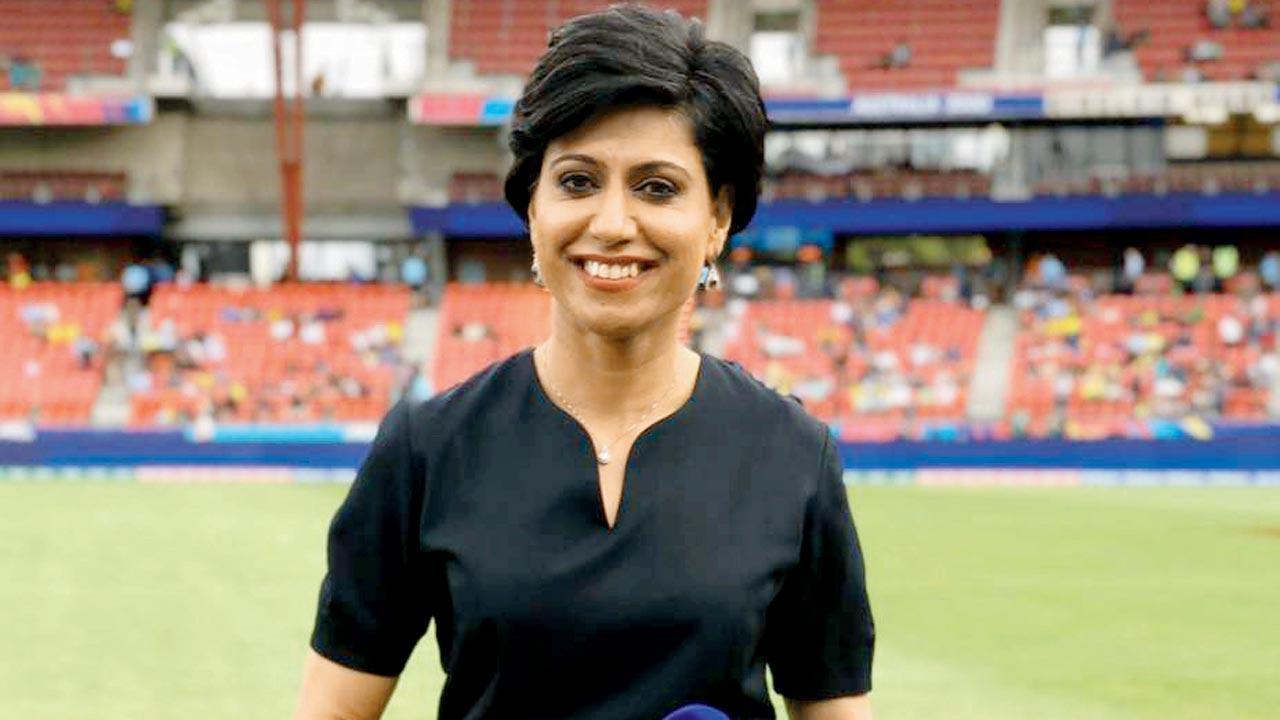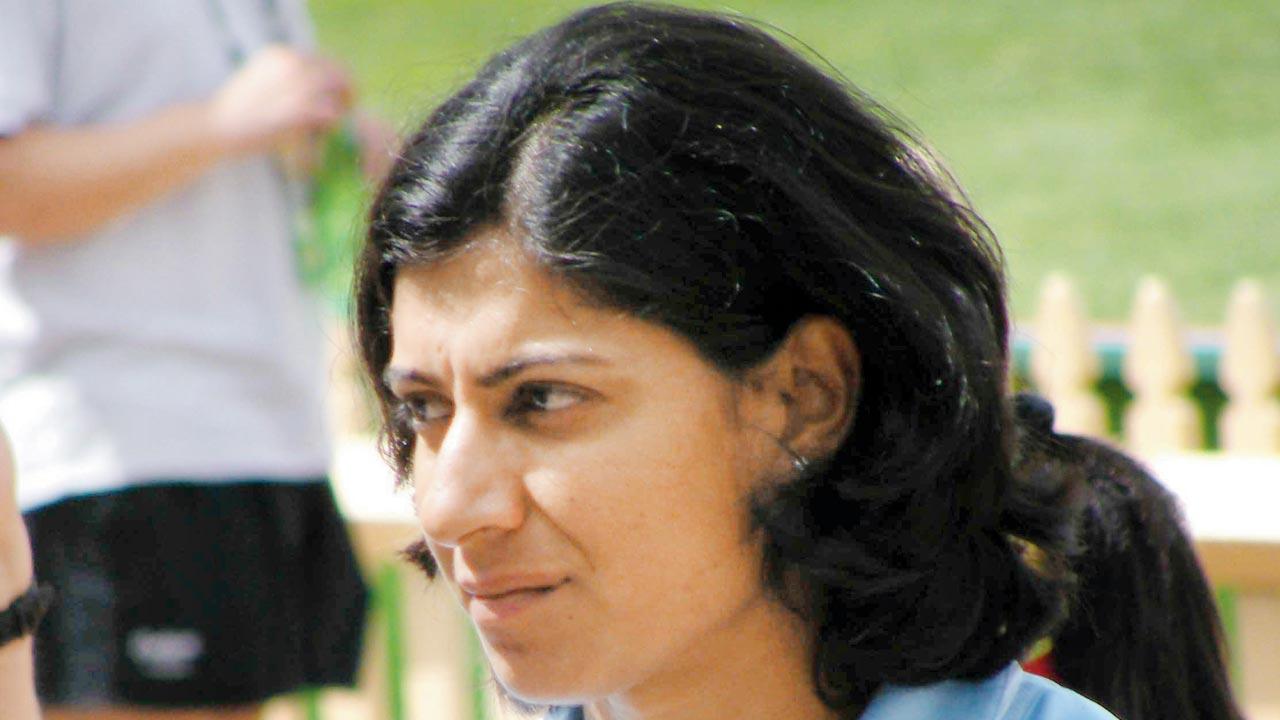From the change of guard to a relook at the structure, Anjum Chopra plays with a straight bat to discuss the challenging road for Indian women’s cricket

At the Women’s T20 World Cup in 2020. As a cricket commentator, she has covered the men and women’s game at the highest level. Pic/Facebook
My wish is for India to win the 2023 World Cup! But Australia is strong, so is South Africa and England. They should put up a good show. After all, India has limited opportunities; barely 10-12 matches until the tournament.”
ADVERTISEMENT
Former team India captain and popular broadcaster, Anjum Chopra is offering a realistic prediction about the Indian women’s national team’s chances when this writer connects with her in Delhi over a telephone call. “That’s the beauty and the bane—they don’t have enough games. So, each time a player goes out to bat or bowl, she knows what’s at stake.”
Chopra would know. Having negotiated the uncharted terrain herself, from a debut in 1995 to her elevation as captain in 2002, the 45-year-old has seen it all. Since she retired from the game in 2012, she has made a name as an analytical sports broadcaster in what’s largely a male bastion. But being a game changer isn’t new for the Arjuna and Padma Shri awardee, whose love affair with cricket has seen her constantly reinvent the wheel. In fact, towards the end of our chat, in reply to a query, she expresses keenness to become an administrator in the women’s game. “I’ve had a few discussions around it. If my expertise and knowledge is required, I will be happy to play a role.”
Edited excerpts from the interview.
What challenges do you face as India’s first woman cricket commentator on the global stage?
I love the sport and have wanted to be associated with it in some capacity. Being a broadcaster allows me to be at the ground and witness it from the closest quarters, which is a privilege.
Also Read: Mumbai: A city of dreams… but not for all
When I began, I received a lot of assistance and was fortunate to work with (and I continue to learn from) some of the best. For me, it was never about stepping on the ground one day and speaking on a mic; I was involved with cricket analysis and studio shows even while I was playing. I’m an avid biker. I have worked as airline professional and I have also captained India. I make the most of opportunities across interests when they come my way.
Just because I have broken the glass ceiling doesn’t offer me surety. You need to keep scoring runs to be counted in a team. Likewise in broadcasting, I have to constantly improve. Homework and awareness matters before you voice your views to the world.
 Anjum Chopra from her playing days in 2009. At the 2009 World Cup in Australia, the team led by Chopra finished third at the World Cup behind England and New Zealand. Pic/Wikimedia Commons
Anjum Chopra from her playing days in 2009. At the 2009 World Cup in Australia, the team led by Chopra finished third at the World Cup behind England and New Zealand. Pic/Wikimedia Commons
How much has being a cricketer helped you in the commentary box?
I believe a major advantage is being able to relate to a particular scenario on the field because you’ve already
been there.
What do you feel about Harmanpreet Kaur becoming India’s new all-format captain?
Whenever a new captain takes over, parallels are drawn between their performances and how they lead the side. In the recent series against Sri Lanka, I observed that she batted and bowled well; she bailed the team out in difficult scenarios in most matches. She also bagged Player of the Series. But I wouldn’t like to rate her [as captain basis one series]. Based on what I’ve seen of her, I feel she should have been given captaincy earlier. She was leading the T20 side since 2016 but India hardly played any T20 cricket.
Harman realises that she is in a different league as a senior who must deliver. When a player is aware of their role, it’s possible to gauge if they’ve understood this responsibility. From my observing her in the past few years, she seems aware. The next three-four years are crucial to pave the way for the next leader to emerge. Mithali passed on the baton but the team hasn’t matured. We need it [leadership] to percolate, whether it’s Deepti [Sharma], Smriti [Mandhana], Poonam [Yadav] or Taniyaa [Bhatia], who have all been in the team for a while. How the balance between Harman, the leader, is played out and this core group, will shape the team.
What challenges prevail in Indian women’s cricket?
The BCCI needs to have a well-defined structure for the women’s game. The more similar it is, the more different it is, you realise, to the men’s game. Forget about the first 15, there is a fight to pick the first 11 of the Indian men’s team [chuckles]. This is the scenario that needs to be achieved in the women’s game too. But it’s far away. BCCI has a great structure that has produced matchwinners. But this didn’t happen overnight. Even with the IPL, it took decades for returns to come. For the women’s game to improve, we need to assess and re-assess the structure; wherever modifications are required that are different from men’s cricket, they need to be made.
So, would a women’s IPL have helped bridge the gap?
It is not about the IPL alone. If it was initiated about four, five or six years ago, the scenario might have been different. But, there is little point raising this now. It’s been 16 years since the ICC merged with the International Women’s Cricket Council where men’s cricket boards across countries took over the women’s game. Our structure is good but not the perfect one for women’s cricket. We need to go backwards to take it forward.
For girls, there is no school cricket; college cricket is also minimal. If not school from school level, the supply chain of senior-level male cricketers emerges from leagues and club cricket. This isn’t the case for women’s cricket.
Favourite moment as commentator
“It was my first time in the commentary box, for the 2007 Afro Asia Cup in Bangalore. Harsha Bhogle, Pommie Mbangwa and Ravi Shastri were there. I remember being awestruck when Mr Shastri was commentating. Suddenly, I felt a tap on my shoulder. It was Harsha, who smiled and said, “Anjum, the match is taking place in front of you, not beside you.”
Rapid Fire
Favourite cricketers to watch: Harmanpreet Kaur and Meg Lanning
Favourite commentator/s: Naseer Hussain, Ian Smith, Ian Bishop, Simon Doull, Mel Jones, Isa Guha
What do you do to switch off? Sleep! It’s the best way to not do anything and relax your mind and body.
 Subscribe today by clicking the link and stay updated with the latest news!" Click here!
Subscribe today by clicking the link and stay updated with the latest news!" Click here!







